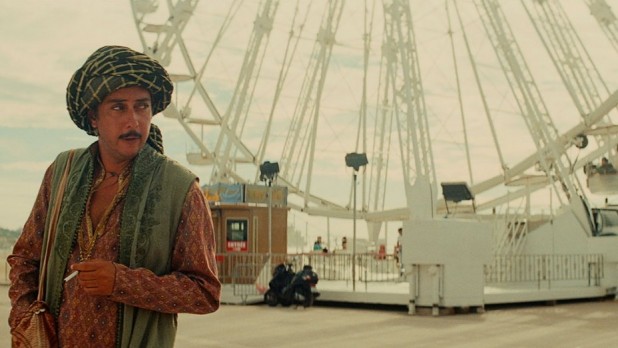
Director: Miguel Gomes | Cast: Christa Alfaiate, Chico Chapas, Americo Silva; Portugal/France/Ger/Switz |125 min.
In part of three of his trilogy The Arabian Nights, entitled The Enchanted One, Portuguese writer and director Miguel Gomes finally moves Scheherazade (Alfaiate) into the centre of this modern retelling of A Thousand and One Nights, set in a a contemporary Portugal haunted by economic decline. Part III consists of three fables that are more interconnected than in the previous section – The Desolate One.
Scheherazade’s own story is told in the outrageously sumptuous Chateau d’If (against the background of high-rise blocks in working class Marseille). The magnificent setting is further enhanced by DoP Mukdeeprom’s resplendent visuals that picture a costume drama that feels more of a f’ilm-in-a-film’ than the previous segments. Scheherazade’s father, the Grand Vizier (Silva) is kitted out in full Ali Baba regalia complete with bulbous headgear. Frightened that his daughter will run out of stories and finally lose her life, he is also lost in nostalgia for his much-loved wife, now dead; and the images of the two women intermingle in his mind. This clearly artificial and theatrical episode echoes Gomes’ Murnau take in Tabu, but it lacks focus, failing somehow to fit into the whole canon.
Leading to the second segment ‘Baghdad Archipelago’, where Scheherazade meets the paddle man (Charloto), who has 200 children, and Elvis, a robber cum street dancer, Gomes suddenly switches to a Godard mode, where multiple texts overload the attention capacity of the audience, particularly the section with subtitles. Inserts like: “From the wishes and fears of men, stories are born” seem clever, but do not add much value. Most of The Enchanted One is taken up by the 80 minute final segment “Chorus of the Chaffiniches” (shot by Lisa Persson), starring again Chico Chapas (Simao in Part II), as a birdsong expert and bird trapper. These bird trappers are mostly unemployed men, and when we one caught in a net meant for the birds, the symbolism is clear. The story of a Chinese girl, told in voice-over, who came to Portugal at the time of the depression, adds a further layer of melancholia to the trilogy’s ending. Still shrouded in enigma and inconclusive, The Enchanted One somehow loses his way, subtracting rather than adding to the whole trilogy.
The structure of Arabian Nights is obviously the main attraction; the narrative, however inventive at times, would not have carried 381 minutes. Gomes has fused Buñuel’s satire, Brechtian allegories and phantasy elements not unlike Fernando Birri in his South American poetic realism. The stylistic variations, sometimes disperse and are often overwhelming, but Mukdeeprom’s images give the Arabian Nights its unique look, and a visual coherence. Whilst the opulence of Arabian Nights is obviously part of its strength, Gomes might have overreached himself a little. He is strongest in the ethnographic chapters, when he shows serous interest in the lives of real people. His choice of popular music, from Rod Stewart to Lionel Ritchie, underlines this argument: his journey between Italian Neorealism and South American Poetic Realism is strongest, when he chooses a pictorial approach. AS
OUT ON GENERAL RELEASE IN SELECTED CINEMAS FROM 6 MAY 2016